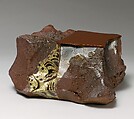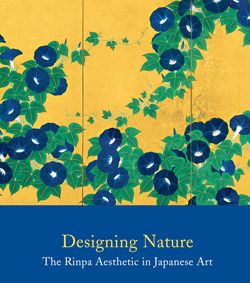Water Jar (Mizusashi) with Stylized Waves
Nakamura Takuo Japanese
Not on view
Water jars, such as this mizusashi, play a pivotal aesthetic role during tea ceremonies, for they are the first and last vessels to be brought into tearooms. Aware of the importance that water jars have long held in the ceremonial context of chanoyu, literally "hot water for tea," Nakamura Takuo produces traditional vessels that impart a new vitality.
Like Momoyama-period (1573–1615) precedents, this water jar exhibits an organic, misshapen form, but it has been molded freely into an unconventional rectangular shape. Nakamura seamlessly juxtaposes walls of roughly textured, glazed clay against sides that are inlaid with gold and silver and hark back to the brilliant wave patterns painted by seventeenth- and eighteenth-century Rinpa artists. The smooth, lacquered auburn lid introduces yet another conspicuous element of contrast. Sculptural yet painterly, decorative but functional, this dynamic water jar continues the tradition even as it breaks from it.
Due to rights restrictions, this image cannot be enlarged, viewed at full screen, or downloaded.


